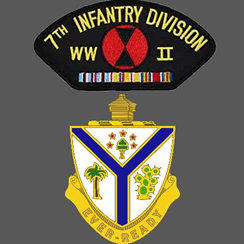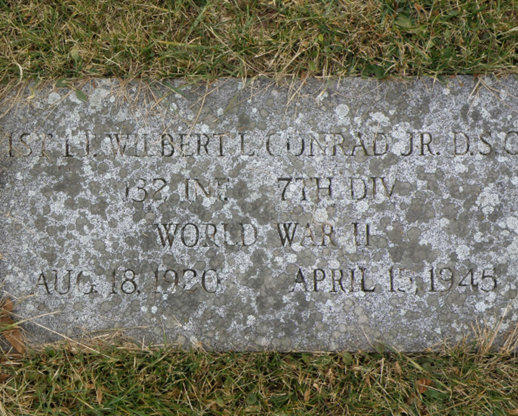
copyright © Wartime Heritage Association 2012-2024
Website hosting courtesy of Register.com - a web.com company
Wartime Heritage
ASSOCIATION
Remembering World War II
Wilbert Leon Conrad Jr.


Sources:
findagrave
honorstates.org
U.S., War Department, Press Releases and Related Records, 1942-1945, July 19, 1944
Name:
Wilbert Leon Conrad Jr.
Rank:
First Lieutenant
Service Number:
O-447463
Service:
132nd Infantry Regiment,
7th Infantry Division, US Army
Awards:
Bronze Star, Distinguished Service Cross,
Purple Heart
Date of Birth:
August 18, 1920
Place of Birth:
Whitefield, Coös County, New Hampshire
Date of Enlistment:
After 1942
Place of Enlistment:
Unknown
Address at Enlistment:
Morrisville, Lamoille County, Vermont
Age at Enlistment:
Occupation:
Unknown
Marital Status:
Unknown
Religion:
Unknown
Next of Kin:
Wilbert Leon Conrad (Father)
Date of Death:
April 15, 1945
Age:
24
Cemetery:
Riverside Cemetery, Lunenburg, Essex County, Vermont
Wilbert Leon Conrad Jr. was the son of Wilbert Leon Conrad (1885-1961) and Mildred Hartshorn Conrad
(1899–1930) (m. 1917). His parents were married in 1917. Wilbert Junior had three siblings – Clarence
Leon Conrad
(1918–1918), Richard R. Conrad (1922–1998), and Joyce Mildred Conrad (1923–1968). His mother was
born in Lunenburg in Essex County, Vermont and coincidently, his father was born in Lunenburg in
Bridgewater County, Nova Scotia.
His father moved to the United Sates in 1918, via the Yarmouth NS ferry, and worked as a surveyor for
pulp wood, a wood buyer for a pulp mill, and later as an insurance agent in New England. His parents
and the children lived in Lunenburg, Vermont until the 1930’s, and by 1940 were living in Morrisville,
VT.
Wilbert enlisted in the US Army sometime after graduating from
the University of Vermont in 1942. He was assigned to the
132nd Infantry Regiment (their motto – Ever Ready), of the 7tth
Infantry Division. He saw action on Attu, in the Marshall Islands,
the Philippines, and on Okinawa.
On January 19, 1944, Wilbert appears on the muster roll of the
US Navy’s USS LST-273. LST 273 was an LST-1 Class Tank Landing
Ship assigned to the Asiatic-Pacific Theatre in WWII, with LST
Flotilla Thirteen, LST Group 38, LST Division 75. The ship
participated in Marshall Islands operation (January, February
1944), Mariana’s operation (June July 1944), and the Tinian
capture and occupation (Jul 1944).
Wilbert also appears on the muster roll of the USS General W. F. Hase (AP-146), a US Navy General G.
O. Squier-class transport ship, in July 1944.
Wilbert served in the Battle of Eniwetok, Eniwetok Atoll, Marshall Islands, fought between February 17
and February 23, 1944. Wilbert was credited “with thwarting the well-paid plans of the Japanese to
blast the American invaders of Engebi and into the sea. Moving through a wall of machine and mortar
fire, disregarding a bullet wound in the neck, he prevented what might have been a slaughter of
doughboys [soldiers] and Marines and ensured establishment of a beachhead.”
The account of Lieutenant Conrad’s busy morning on the central Pacific atoll is based on eyewitness
observation of two Infantryman, Staff Sergeants William F. Stover of Box 806, Weed, California, and
Henry G. Serverson of R.F.D. 1, Climax, Minnesota.
“Lieutenant Conrad commanded the first wave of amphibian tractors, or ‘alligators’, carrying Assault
Marine troops. As the first wave approached the beach artillery fire raised a blanket of dust that was
blown over the alligators by an offshore wind, obscuring the shoreline.”
“As the alligators hit the beach and the dust cleared, said Stover, who commanded one of the troop-
carrying tractors, we were brought under terrific fire from [enemy] machine guns, set up an airport at
the left flank of the beach.”
“This beach rose abruptly into a steep bank and there wasn’t any room for the vehicles to manoeuvre,
so when the Marines jumped to the ground they were immediately pinned down by machinegun,
sniper and mortar fire.”
“With [enemy] mortar shells falling among the Marines and Infantrymen on the beach, [enemy] snipers
began picking off our machine gunners on the alligators.”
“Lieut. Conrad got on top of his alligator to see what was going on. He saw the situation, saw the
tractors couldn’t move, and observed the casualties resulting from [enemy] fire. He jumped to the
ground and began to move the troops from around the vehicles.”
“Then he led the tractors up onto the crest of the beach so we could pour more fire into the enemy
positions on the airport.”
“Cheering the lieutenant for his disregard of enemy fire, the Marines moved off the beach strip behind
the tractors. He kept moving around, ordering each group of men and each vehicle forward. An
[enemy] machine gun sliced the heel off one of his boots. He paid no attention to it.”
“When the beach was cleared, permitting succeeding waves of alligators to land, Lieut. Conrad started
inland to join his own vehicle. Another tractor commander warned him that a Japanese pillbox blocked
his path. The lieutenant, determined to carry on with his job, disregarded the warning. A moment
later, a sniper firing from the pillbox, shot him in the neck.”
“But not until he was certain the beachhead had been established, did the Yankee Infantry Officer
consent to treatment of his wound and evacuation to one of the troopships standing offshore.”
Sergeant Severson declared: “The Lieutenant not only prevented that beach from becoming a bloody
shambles for us, but he kept us from suffering many
casualties even before we hit the beach. When the wind and
dust shut off the island from our view, he sensed that our
artillery fire still was being laid on the beach and halted the
wave of alligators. This exact timing not only held down our
casualties but allowed us to take full advantage of the
artillery fire.”
Wilbert survived the combat in the Marshall Islands and also
took part in the fighting in the Philippines.
First Lieutenant Wilbert Leon Conrad Jr. died of wounds
received in action on April 15, 1945, in the Battle of
Okinawa which was launched on April 1, 1945 (the article
from the paper states he died at Guam. His body was
returned stateside from Guam; but he died in the fighting at
Okinawa.)
Wilbert’s father chose to repatriate his body and he was
interred at the Riverside Cemetery in Lunenburg, Essex
County, Vermont.
Wilbert’s name is also listed on the Peace Park Memorial in
Okinawa, Japan.






- World War I - Menu
- WWI Stories and Articles
- Photos - Yarmouth Soldiers
- Selection of World War I Songs
- WWI Casualties of Yarmouth, NS
- Those Who Served - Yarmouth, NS
- WWI Casualties Digby Co. NS
- WWI Casualties Shelburne Co. NS
- Merchant Mariners (1915) Yarmouth, NS
- Canadian Forestry Corps - Non Yarmouth Birth/Residence Enlistments
- US Draft Registry - Yarmouth NS Born


- World War II - Menu
- WWII Stories and Articles
- Telegraphist Air Gunners
- WWII Casualties of Nova Scotia
- US Casualties with NS Connection
- Far East/Pacific Casualties with NS Connection
- Merchant Navy Casualties Nova Scotia
- Nova Scotia WWII Casualties Holten Canadian War Cemetery
- D-Day Casualties - Nova Scotia
- CANLOAN Program Casulaties - Nova Scotia
- Battle of the Bulge Casualties - Nova Scotia
- WWII Casualties Yarmouth NS
- Yarmouth Casualties - RCAF RAF Canadian Army WWII
- Yarmouth Co., Marrages WWII
- Casualties Non-Born/Residents with Connection to Yarmouth Co., Nova Scotia.
- WWII Casualties Digby Co., NS
- Non-Nova Scotian WWII Casualties Buried in Nova Scotia
- WWII RCAF Casualties Aged 16-18
- Brothers/Sisters Who Served - World War II













